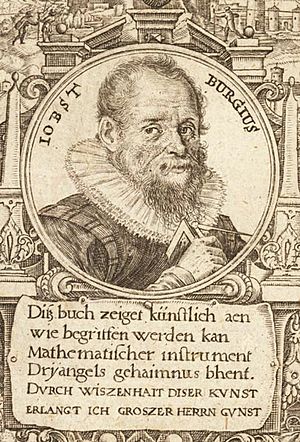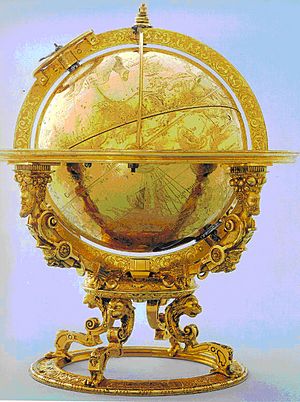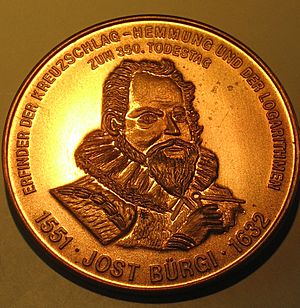Jost Bürgi facts for kids
Quick facts for kids
Jost Bürgi
|
|
|---|---|
 |
|
| Born | 28 February 1552 Lichtensteig, Toggenburg, Switzerland
|
| Died | 31 January 1632 (aged 79) |
| Known for | Logarithms |
| Scientific career | |
| Fields | Mathematician |
Jost Bürgi (born February 28, 1552 – died January 31, 1632) was a brilliant Swiss clockmaker, instrument maker, and mathematician. He worked for kings and emperors in Kassel and Prague. Bürgi was known for making very accurate clocks and for his work on logarithms.
Contents
Early Life and Work
Jost Bürgi was born in 1552 in Lichtensteig, Switzerland. Not much is known about his early life or how he learned his skills. People think he might have learned mathematics in Strasbourg.
Even though he taught himself, Bürgi was seen as one of the best engineers of his time. His boss, William IV, Landgrave of Hesse-Kassel, called him a "second Archimedes." This shows how much William IV admired Bürgi's talent.
In 1604, Bürgi started working for Emperor Rudolf II in Prague. There, he became good friends with the famous astronomer Johannes Kepler.
Bürgi's Amazing Clocks
We don't know where Bürgi learned to make clocks. But he became the most creative clock and science instrument maker of his time. He invented new parts for clocks, like the cross-beat escapement and the remontoire.
These inventions made mechanical clocks much more accurate. For the first time, clocks could be used as scientific tools. They were precise enough to time the movement of stars through telescopes. This helped scientists create better maps of the stars.
Bürgi worked for William IV in Kassel, helping to create the first detailed star charts. He also invented logarithms as a tool for his own calculations. Logarithms helped him do complex math much faster. However, Bürgi didn't publish his invention for a long time. He was more of a "craftsman/scholar" than a "book scholar."
In 1592, Emperor Rudolf II saw one of Bürgi's special globes. He liked it so much that he asked Bürgi to deliver it himself. After that, Bürgi traveled between Kassel and Prague. Finally, in 1604, he started working full-time for the emperor. He worked closely with Johannes Kepler, the imperial astronomer.
Bürgi's Inventions and Works
Many of the amazing things Bürgi designed and built are still in museums today. Here are some of them:
- Several special globes that show how the stars move. You can find them in Paris, Zürich, Kassel, and Weimar.
- Many clocks in Kassel, Dresden, and Vienna. These include a clock made of quartz and one that shows how planets move.
- Sextants made for Kepler, which are in the National Technical Museum in Prague.
- A mechanical model that shows the moon's irregular movement around Earth. This is in Kassel.
- A mechanical armillary sphere in Upsala, Sweden.
Bürgi's Math Discoveries
Bürgi was also a very skilled mathematician. He made important contributions to trigonometry and logarithms.
Bürgi's Work on Trigonometry
By 1586, Bürgi could calculate sines with great accuracy. He used special methods, one of which he called Kunstweg. He used these methods to create a table of sines called the Canon Sinuum. This table was said to be very precise.
Such tables were extremely important for navigation at sea. They helped sailors figure out their position. Johannes Kepler called Bürgi's Canon Sinuum the most precise table of sines known. Bürgi explained his methods in his work Fundamentum Astronomiae. He showed this work to Emperor Rudolf II in 1592.
Bürgi's Work on Logarithms
Bürgi created a table of progressions, which are now known as antilogarithms. He did this independently of another mathematician, John Napier. Napier published his discovery in 1614. Bürgi may have made his table around 1600.
Bürgi's method was different from Napier's. His table served the same purpose as Napier's, making calculations easier. Johannes Kepler wrote about Bürgi's logarithms in his book, the Rudolphine Tables (1627). Kepler said that Bürgi had found these logarithms many years before Napier. But Bürgi was a quiet person and didn't publish his work right away.
Honors and Legacy
The lunar crater Byrgius is named in honor of Jost Bürgi. This shows his lasting impact on science and astronomy.
See also
 In Spanish: Joost Bürgi para niños
In Spanish: Joost Bürgi para niños




